BMP4005 - Information Systems & Big Data Analysis Business Report
VerifiedAdded on 2023/06/10
|8
|1893
|336
Report
AI Summary
This report provides an overview of big data, its characteristics, and the challenges associated with its analysis. It explores various techniques for analyzing big data, including A/B testing, data fusion, data mining, machine learning, and statistics. The report further discusses how big data technology can support business by improving decision-making, enhancing existing products, ensuring data safety, and aligning with customer preferences. Examples are provided to illustrate the practical applications of big data analytics in achieving business success. Desklib offers a variety of resources for students, including similar solved assignments and past papers.
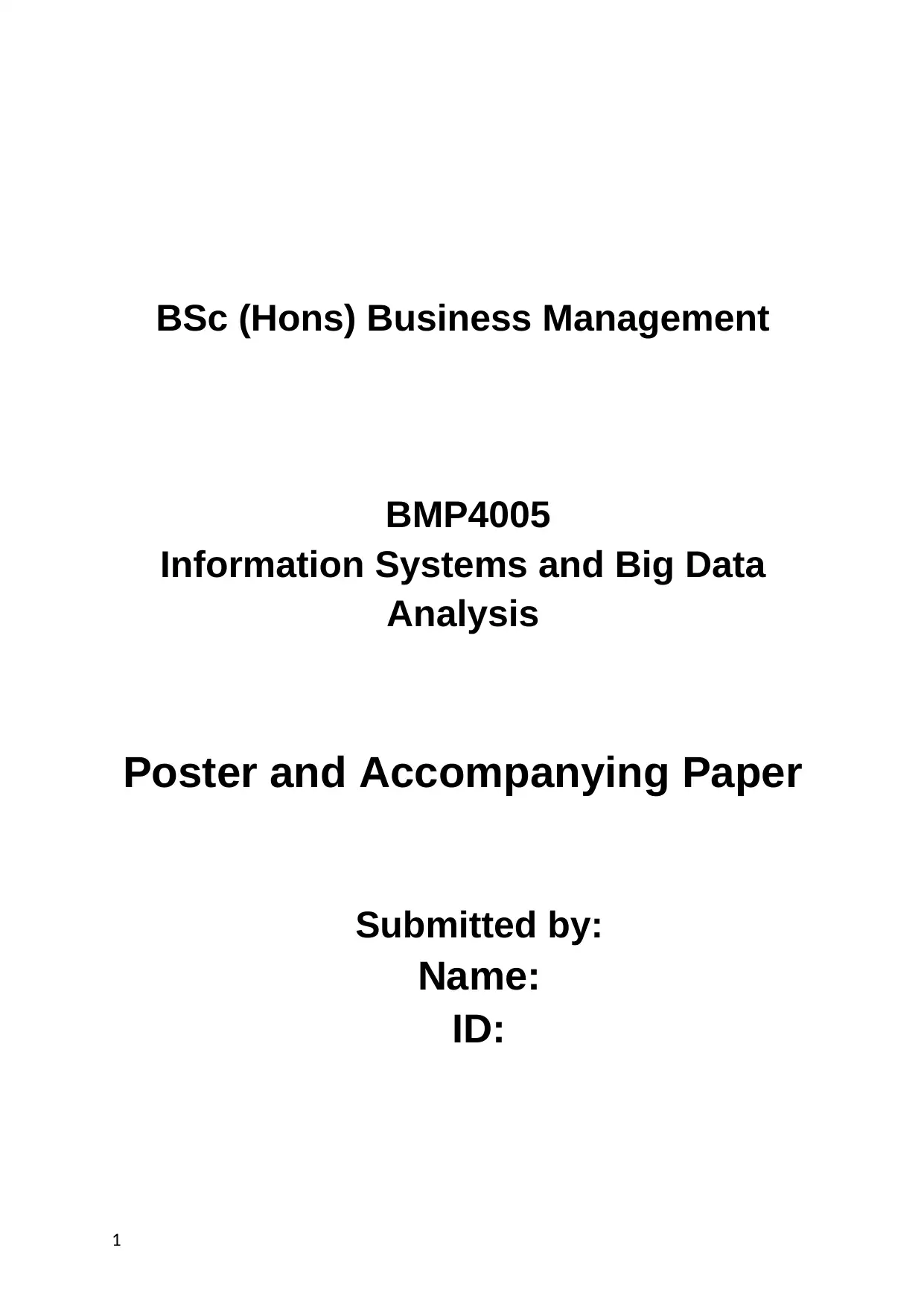
BSc (Hons) Business Management
BMP4005
Information Systems and Big Data
Analysis
Poster and Accompanying Paper
Submitted by:
Name:
ID:
1
BMP4005
Information Systems and Big Data
Analysis
Poster and Accompanying Paper
Submitted by:
Name:
ID:
1
Paraphrase This Document
Need a fresh take? Get an instant paraphrase of this document with our AI Paraphraser

Table of content
Introduction...............................................................................................................................3
What big data is and the characteristics of big data..........................................................3
The challenges of big data analytics....................................................................................4
The techniques that are currently available to analyse big data......................................5
How Big Data technology could support business, an explanation with examples......6
Conclusion..................................................................................................................................7
Poster........................................................................................................................................7
References...............................................................................................................................8
2
Introduction...............................................................................................................................3
What big data is and the characteristics of big data..........................................................3
The challenges of big data analytics....................................................................................4
The techniques that are currently available to analyse big data......................................5
How Big Data technology could support business, an explanation with examples......6
Conclusion..................................................................................................................................7
Poster........................................................................................................................................7
References...............................................................................................................................8
2
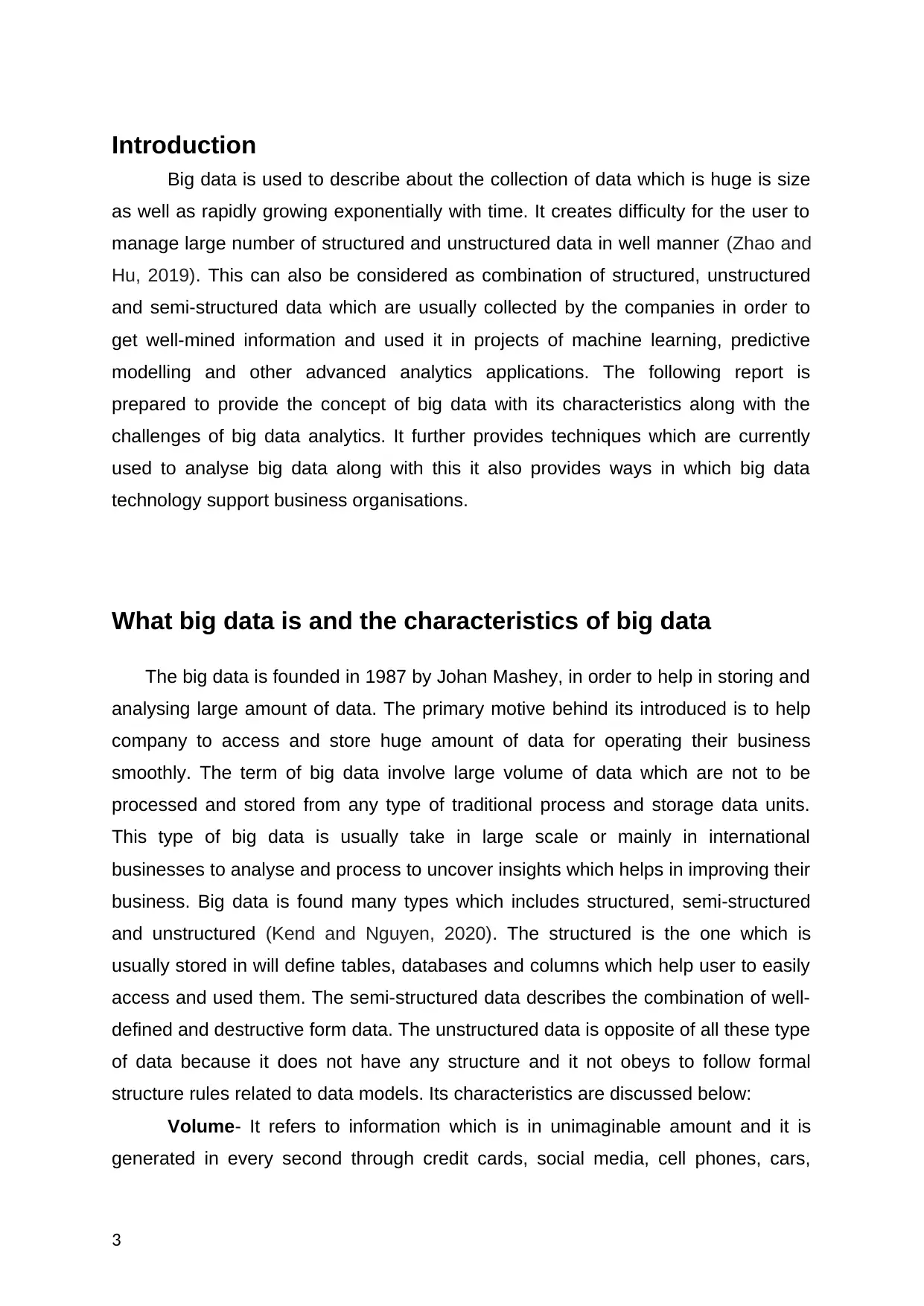
Introduction
Big data is used to describe about the collection of data which is huge is size
as well as rapidly growing exponentially with time. It creates difficulty for the user to
manage large number of structured and unstructured data in well manner (Zhao and
Hu, 2019). This can also be considered as combination of structured, unstructured
and semi-structured data which are usually collected by the companies in order to
get well-mined information and used it in projects of machine learning, predictive
modelling and other advanced analytics applications. The following report is
prepared to provide the concept of big data with its characteristics along with the
challenges of big data analytics. It further provides techniques which are currently
used to analyse big data along with this it also provides ways in which big data
technology support business organisations.
What big data is and the characteristics of big data
The big data is founded in 1987 by Johan Mashey, in order to help in storing and
analysing large amount of data. The primary motive behind its introduced is to help
company to access and store huge amount of data for operating their business
smoothly. The term of big data involve large volume of data which are not to be
processed and stored from any type of traditional process and storage data units.
This type of big data is usually take in large scale or mainly in international
businesses to analyse and process to uncover insights which helps in improving their
business. Big data is found many types which includes structured, semi-structured
and unstructured (Kend and Nguyen, 2020). The structured is the one which is
usually stored in will define tables, databases and columns which help user to easily
access and used them. The semi-structured data describes the combination of well-
defined and destructive form data. The unstructured data is opposite of all these type
of data because it does not have any structure and it not obeys to follow formal
structure rules related to data models. Its characteristics are discussed below:
Volume- It refers to information which is in unimaginable amount and it is
generated in every second through credit cards, social media, cell phones, cars,
3
Big data is used to describe about the collection of data which is huge is size
as well as rapidly growing exponentially with time. It creates difficulty for the user to
manage large number of structured and unstructured data in well manner (Zhao and
Hu, 2019). This can also be considered as combination of structured, unstructured
and semi-structured data which are usually collected by the companies in order to
get well-mined information and used it in projects of machine learning, predictive
modelling and other advanced analytics applications. The following report is
prepared to provide the concept of big data with its characteristics along with the
challenges of big data analytics. It further provides techniques which are currently
used to analyse big data along with this it also provides ways in which big data
technology support business organisations.
What big data is and the characteristics of big data
The big data is founded in 1987 by Johan Mashey, in order to help in storing and
analysing large amount of data. The primary motive behind its introduced is to help
company to access and store huge amount of data for operating their business
smoothly. The term of big data involve large volume of data which are not to be
processed and stored from any type of traditional process and storage data units.
This type of big data is usually take in large scale or mainly in international
businesses to analyse and process to uncover insights which helps in improving their
business. Big data is found many types which includes structured, semi-structured
and unstructured (Kend and Nguyen, 2020). The structured is the one which is
usually stored in will define tables, databases and columns which help user to easily
access and used them. The semi-structured data describes the combination of well-
defined and destructive form data. The unstructured data is opposite of all these type
of data because it does not have any structure and it not obeys to follow formal
structure rules related to data models. Its characteristics are discussed below:
Volume- It refers to information which is in unimaginable amount and it is
generated in every second through credit cards, social media, cell phones, cars,
3
⊘ This is a preview!⊘
Do you want full access?
Subscribe today to unlock all pages.

Trusted by 1+ million students worldwide
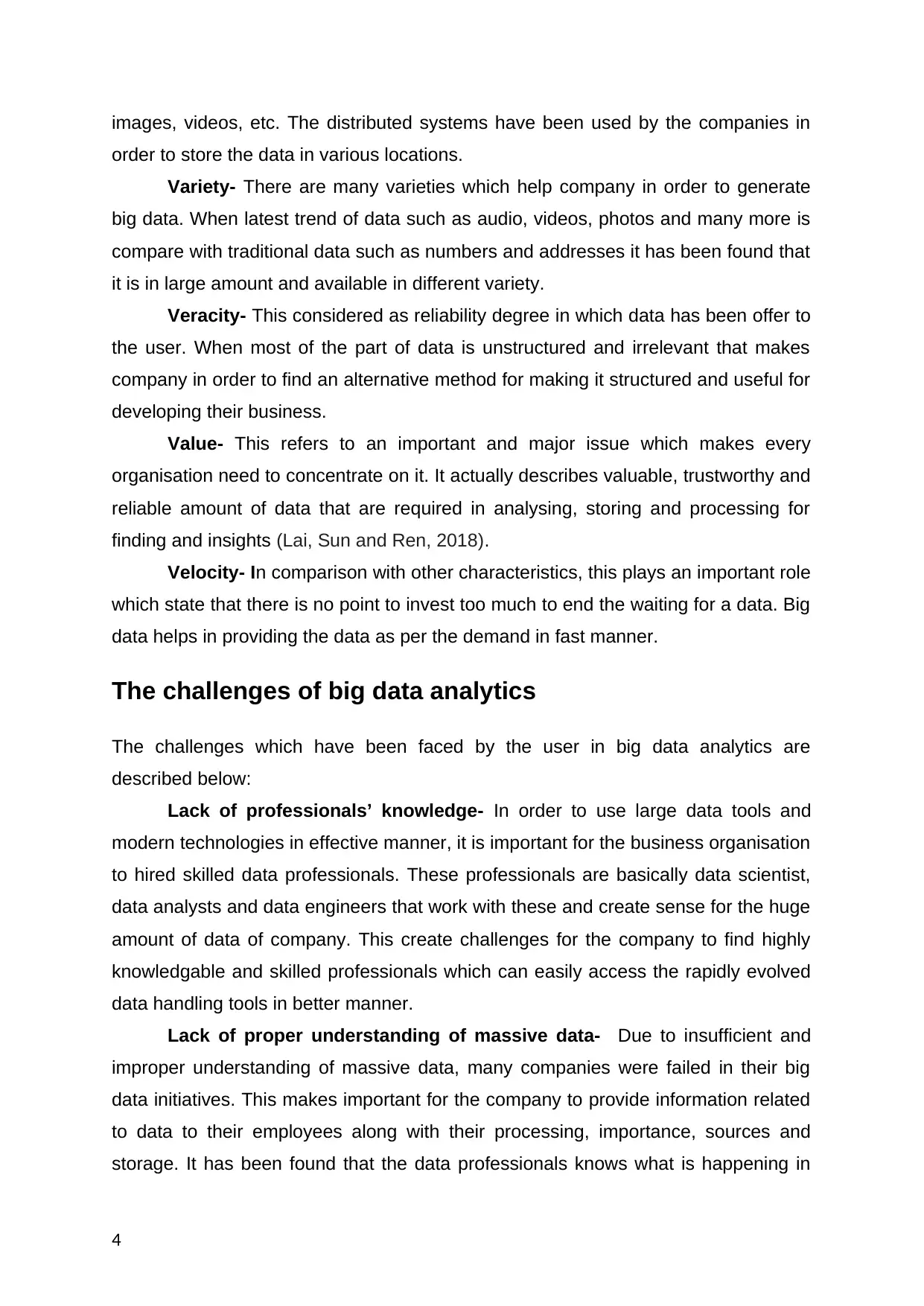
images, videos, etc. The distributed systems have been used by the companies in
order to store the data in various locations.
Variety- There are many varieties which help company in order to generate
big data. When latest trend of data such as audio, videos, photos and many more is
compare with traditional data such as numbers and addresses it has been found that
it is in large amount and available in different variety.
Veracity- This considered as reliability degree in which data has been offer to
the user. When most of the part of data is unstructured and irrelevant that makes
company in order to find an alternative method for making it structured and useful for
developing their business.
Value- This refers to an important and major issue which makes every
organisation need to concentrate on it. It actually describes valuable, trustworthy and
reliable amount of data that are required in analysing, storing and processing for
finding and insights (Lai, Sun and Ren, 2018).
Velocity- In comparison with other characteristics, this plays an important role
which state that there is no point to invest too much to end the waiting for a data. Big
data helps in providing the data as per the demand in fast manner.
The challenges of big data analytics
The challenges which have been faced by the user in big data analytics are
described below:
Lack of professionals’ knowledge- In order to use large data tools and
modern technologies in effective manner, it is important for the business organisation
to hired skilled data professionals. These professionals are basically data scientist,
data analysts and data engineers that work with these and create sense for the huge
amount of data of company. This create challenges for the company to find highly
knowledgable and skilled professionals which can easily access the rapidly evolved
data handling tools in better manner.
Lack of proper understanding of massive data- Due to insufficient and
improper understanding of massive data, many companies were failed in their big
data initiatives. This makes important for the company to provide information related
to data to their employees along with their processing, importance, sources and
storage. It has been found that the data professionals knows what is happening in
4
order to store the data in various locations.
Variety- There are many varieties which help company in order to generate
big data. When latest trend of data such as audio, videos, photos and many more is
compare with traditional data such as numbers and addresses it has been found that
it is in large amount and available in different variety.
Veracity- This considered as reliability degree in which data has been offer to
the user. When most of the part of data is unstructured and irrelevant that makes
company in order to find an alternative method for making it structured and useful for
developing their business.
Value- This refers to an important and major issue which makes every
organisation need to concentrate on it. It actually describes valuable, trustworthy and
reliable amount of data that are required in analysing, storing and processing for
finding and insights (Lai, Sun and Ren, 2018).
Velocity- In comparison with other characteristics, this plays an important role
which state that there is no point to invest too much to end the waiting for a data. Big
data helps in providing the data as per the demand in fast manner.
The challenges of big data analytics
The challenges which have been faced by the user in big data analytics are
described below:
Lack of professionals’ knowledge- In order to use large data tools and
modern technologies in effective manner, it is important for the business organisation
to hired skilled data professionals. These professionals are basically data scientist,
data analysts and data engineers that work with these and create sense for the huge
amount of data of company. This create challenges for the company to find highly
knowledgable and skilled professionals which can easily access the rapidly evolved
data handling tools in better manner.
Lack of proper understanding of massive data- Due to insufficient and
improper understanding of massive data, many companies were failed in their big
data initiatives. This makes important for the company to provide information related
to data to their employees along with their processing, importance, sources and
storage. It has been found that the data professionals knows what is happening in
4
Paraphrase This Document
Need a fresh take? Get an instant paraphrase of this document with our AI Paraphraser
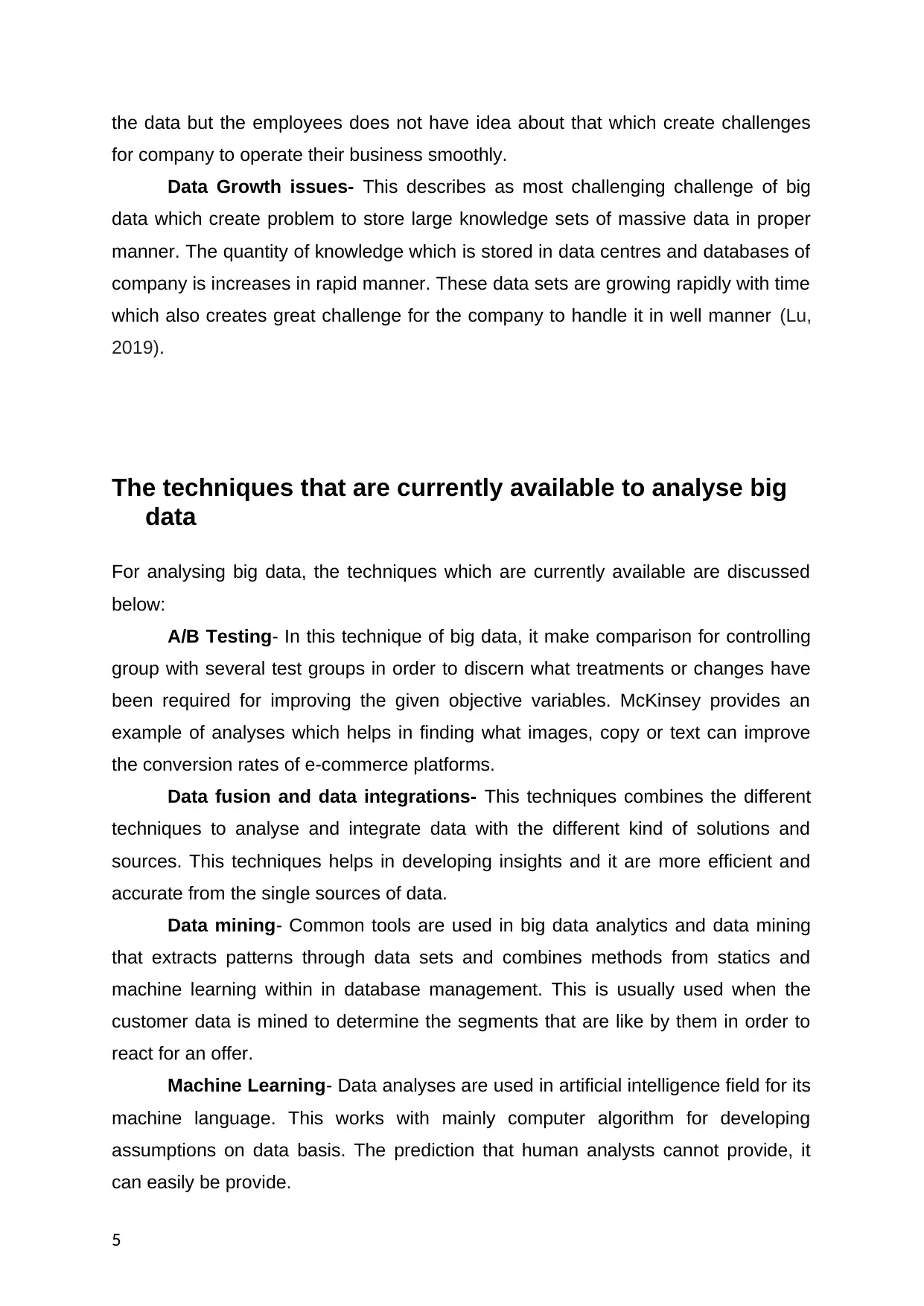
the data but the employees does not have idea about that which create challenges
for company to operate their business smoothly.
Data Growth issues- This describes as most challenging challenge of big
data which create problem to store large knowledge sets of massive data in proper
manner. The quantity of knowledge which is stored in data centres and databases of
company is increases in rapid manner. These data sets are growing rapidly with time
which also creates great challenge for the company to handle it in well manner (Lu,
2019).
The techniques that are currently available to analyse big
data
For analysing big data, the techniques which are currently available are discussed
below:
A/B Testing- In this technique of big data, it make comparison for controlling
group with several test groups in order to discern what treatments or changes have
been required for improving the given objective variables. McKinsey provides an
example of analyses which helps in finding what images, copy or text can improve
the conversion rates of e-commerce platforms.
Data fusion and data integrations- This techniques combines the different
techniques to analyse and integrate data with the different kind of solutions and
sources. This techniques helps in developing insights and it are more efficient and
accurate from the single sources of data.
Data mining- Common tools are used in big data analytics and data mining
that extracts patterns through data sets and combines methods from statics and
machine learning within in database management. This is usually used when the
customer data is mined to determine the segments that are like by them in order to
react for an offer.
Machine Learning- Data analyses are used in artificial intelligence field for its
machine language. This works with mainly computer algorithm for developing
assumptions on data basis. The prediction that human analysts cannot provide, it
can easily be provide.
5
for company to operate their business smoothly.
Data Growth issues- This describes as most challenging challenge of big
data which create problem to store large knowledge sets of massive data in proper
manner. The quantity of knowledge which is stored in data centres and databases of
company is increases in rapid manner. These data sets are growing rapidly with time
which also creates great challenge for the company to handle it in well manner (Lu,
2019).
The techniques that are currently available to analyse big
data
For analysing big data, the techniques which are currently available are discussed
below:
A/B Testing- In this technique of big data, it make comparison for controlling
group with several test groups in order to discern what treatments or changes have
been required for improving the given objective variables. McKinsey provides an
example of analyses which helps in finding what images, copy or text can improve
the conversion rates of e-commerce platforms.
Data fusion and data integrations- This techniques combines the different
techniques to analyse and integrate data with the different kind of solutions and
sources. This techniques helps in developing insights and it are more efficient and
accurate from the single sources of data.
Data mining- Common tools are used in big data analytics and data mining
that extracts patterns through data sets and combines methods from statics and
machine learning within in database management. This is usually used when the
customer data is mined to determine the segments that are like by them in order to
react for an offer.
Machine Learning- Data analyses are used in artificial intelligence field for its
machine language. This works with mainly computer algorithm for developing
assumptions on data basis. The prediction that human analysts cannot provide, it
can easily be provide.
5
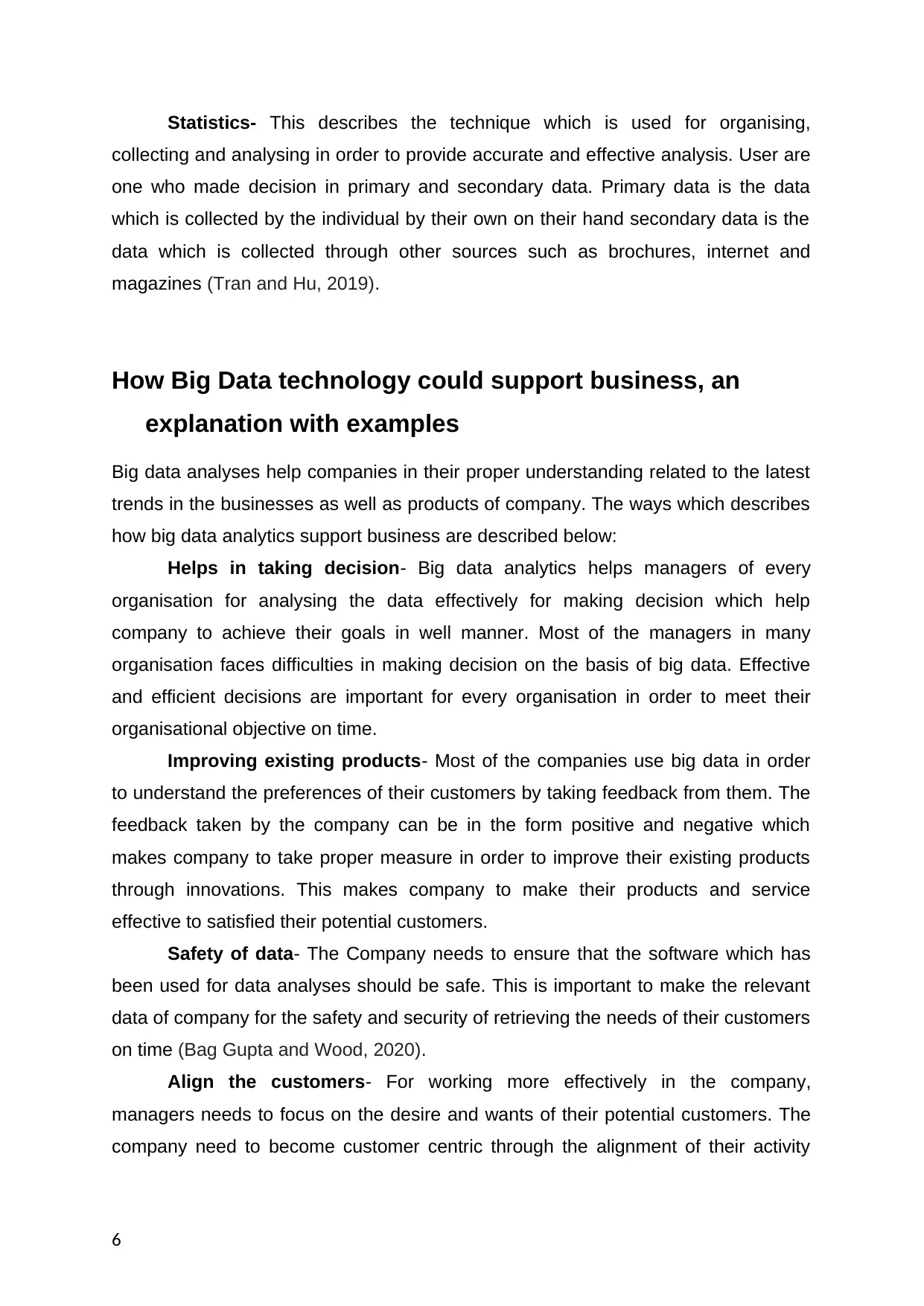
Statistics- This describes the technique which is used for organising,
collecting and analysing in order to provide accurate and effective analysis. User are
one who made decision in primary and secondary data. Primary data is the data
which is collected by the individual by their own on their hand secondary data is the
data which is collected through other sources such as brochures, internet and
magazines (Tran and Hu, 2019).
How Big Data technology could support business, an
explanation with examples
Big data analyses help companies in their proper understanding related to the latest
trends in the businesses as well as products of company. The ways which describes
how big data analytics support business are described below:
Helps in taking decision- Big data analytics helps managers of every
organisation for analysing the data effectively for making decision which help
company to achieve their goals in well manner. Most of the managers in many
organisation faces difficulties in making decision on the basis of big data. Effective
and efficient decisions are important for every organisation in order to meet their
organisational objective on time.
Improving existing products- Most of the companies use big data in order
to understand the preferences of their customers by taking feedback from them. The
feedback taken by the company can be in the form positive and negative which
makes company to take proper measure in order to improve their existing products
through innovations. This makes company to make their products and service
effective to satisfied their potential customers.
Safety of data- The Company needs to ensure that the software which has
been used for data analyses should be safe. This is important to make the relevant
data of company for the safety and security of retrieving the needs of their customers
on time (Bag Gupta and Wood, 2020).
Align the customers- For working more effectively in the company,
managers needs to focus on the desire and wants of their potential customers. The
company need to become customer centric through the alignment of their activity
6
collecting and analysing in order to provide accurate and effective analysis. User are
one who made decision in primary and secondary data. Primary data is the data
which is collected by the individual by their own on their hand secondary data is the
data which is collected through other sources such as brochures, internet and
magazines (Tran and Hu, 2019).
How Big Data technology could support business, an
explanation with examples
Big data analyses help companies in their proper understanding related to the latest
trends in the businesses as well as products of company. The ways which describes
how big data analytics support business are described below:
Helps in taking decision- Big data analytics helps managers of every
organisation for analysing the data effectively for making decision which help
company to achieve their goals in well manner. Most of the managers in many
organisation faces difficulties in making decision on the basis of big data. Effective
and efficient decisions are important for every organisation in order to meet their
organisational objective on time.
Improving existing products- Most of the companies use big data in order
to understand the preferences of their customers by taking feedback from them. The
feedback taken by the company can be in the form positive and negative which
makes company to take proper measure in order to improve their existing products
through innovations. This makes company to make their products and service
effective to satisfied their potential customers.
Safety of data- The Company needs to ensure that the software which has
been used for data analyses should be safe. This is important to make the relevant
data of company for the safety and security of retrieving the needs of their customers
on time (Bag Gupta and Wood, 2020).
Align the customers- For working more effectively in the company,
managers needs to focus on the desire and wants of their potential customers. The
company need to become customer centric through the alignment of their activity
6
⊘ This is a preview!⊘
Do you want full access?
Subscribe today to unlock all pages.

Trusted by 1+ million students worldwide
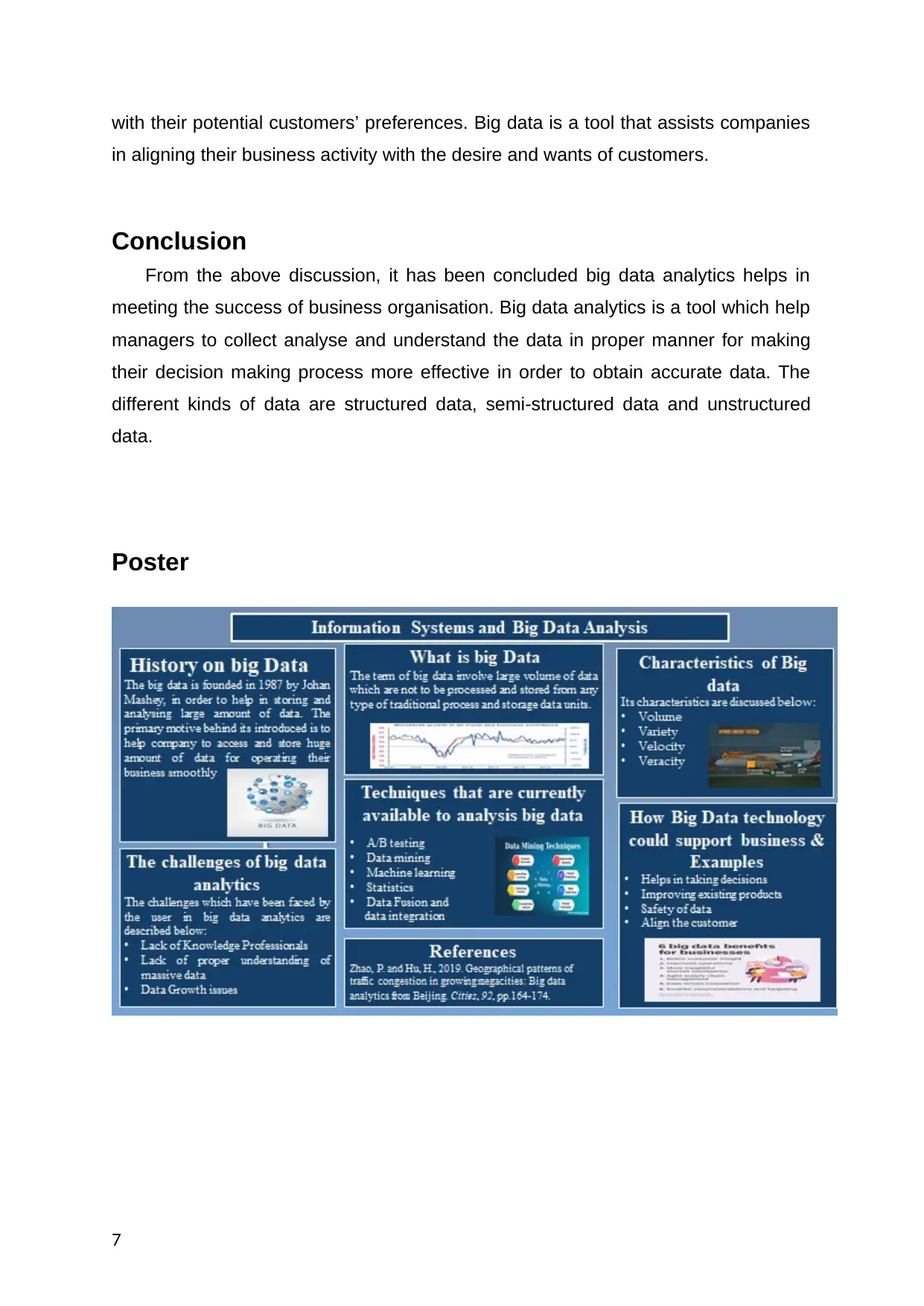
with their potential customers’ preferences. Big data is a tool that assists companies
in aligning their business activity with the desire and wants of customers.
Conclusion
From the above discussion, it has been concluded big data analytics helps in
meeting the success of business organisation. Big data analytics is a tool which help
managers to collect analyse and understand the data in proper manner for making
their decision making process more effective in order to obtain accurate data. The
different kinds of data are structured data, semi-structured data and unstructured
data.
Poster
7
in aligning their business activity with the desire and wants of customers.
Conclusion
From the above discussion, it has been concluded big data analytics helps in
meeting the success of business organisation. Big data analytics is a tool which help
managers to collect analyse and understand the data in proper manner for making
their decision making process more effective in order to obtain accurate data. The
different kinds of data are structured data, semi-structured data and unstructured
data.
Poster
7
Paraphrase This Document
Need a fresh take? Get an instant paraphrase of this document with our AI Paraphraser
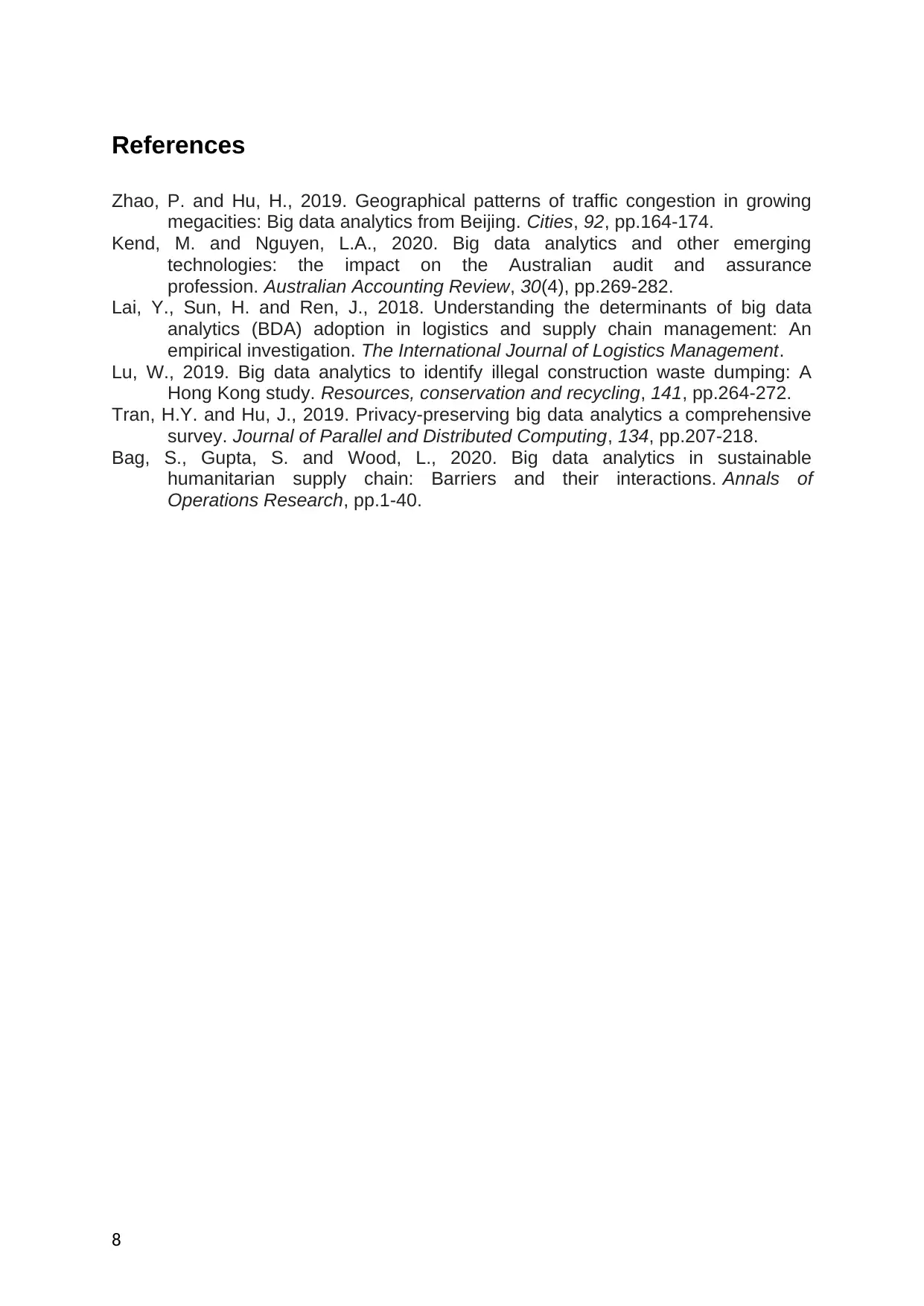
References
Zhao, P. and Hu, H., 2019. Geographical patterns of traffic congestion in growing
megacities: Big data analytics from Beijing. Cities, 92, pp.164-174.
Kend, M. and Nguyen, L.A., 2020. Big data analytics and other emerging
technologies: the impact on the Australian audit and assurance
profession. Australian Accounting Review, 30(4), pp.269-282.
Lai, Y., Sun, H. and Ren, J., 2018. Understanding the determinants of big data
analytics (BDA) adoption in logistics and supply chain management: An
empirical investigation. The International Journal of Logistics Management.
Lu, W., 2019. Big data analytics to identify illegal construction waste dumping: A
Hong Kong study. Resources, conservation and recycling, 141, pp.264-272.
Tran, H.Y. and Hu, J., 2019. Privacy-preserving big data analytics a comprehensive
survey. Journal of Parallel and Distributed Computing, 134, pp.207-218.
Bag, S., Gupta, S. and Wood, L., 2020. Big data analytics in sustainable
humanitarian supply chain: Barriers and their interactions. Annals of
Operations Research, pp.1-40.
8
Zhao, P. and Hu, H., 2019. Geographical patterns of traffic congestion in growing
megacities: Big data analytics from Beijing. Cities, 92, pp.164-174.
Kend, M. and Nguyen, L.A., 2020. Big data analytics and other emerging
technologies: the impact on the Australian audit and assurance
profession. Australian Accounting Review, 30(4), pp.269-282.
Lai, Y., Sun, H. and Ren, J., 2018. Understanding the determinants of big data
analytics (BDA) adoption in logistics and supply chain management: An
empirical investigation. The International Journal of Logistics Management.
Lu, W., 2019. Big data analytics to identify illegal construction waste dumping: A
Hong Kong study. Resources, conservation and recycling, 141, pp.264-272.
Tran, H.Y. and Hu, J., 2019. Privacy-preserving big data analytics a comprehensive
survey. Journal of Parallel and Distributed Computing, 134, pp.207-218.
Bag, S., Gupta, S. and Wood, L., 2020. Big data analytics in sustainable
humanitarian supply chain: Barriers and their interactions. Annals of
Operations Research, pp.1-40.
8
1 out of 8
Related Documents
Your All-in-One AI-Powered Toolkit for Academic Success.
+13062052269
info@desklib.com
Available 24*7 on WhatsApp / Email
![[object Object]](/_next/static/media/star-bottom.7253800d.svg)
Unlock your academic potential
Copyright © 2020–2025 A2Z Services. All Rights Reserved. Developed and managed by ZUCOL.

